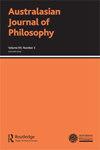玛丽·谢泼德关于外部宇宙感知的随笔
IF 1
2区 哲学
0 PHILOSOPHY
引用次数: 1
摘要
谢泼德1827年出版的这本新书是《牛津新哲学史》的一个非常受欢迎的补充,包括长篇《学术或怀疑哲学随笔》和十四篇短文,以及1832年的《玛丽·谢泼德夫人的形而上学》。《感知外部宇宙的散文》在很大程度上依赖于谢泼德1824年的《因果关系散文》(该系列即将出版)中提出的原则,即没有什么东西可以开始自己的存在,完全相似的影响必须具有完全相似的原因。在这里,谢泼德用它们来反对休谟和伯克利,认为我们的知识来源于一个持续存在的、外部的、独立的世界的理性。这是谢泼德的任何一本书的第一个现代学术版本,安东尼娅·洛洛多为处理极其丰富、往往令人生畏的文本提供了一个非常有用的解释工具。她标记了谢泼德对她早期作品的引用,追踪了谢泼德·谢泼德的许多典故,并确定了接受康德的可能渠道。洛洛多简洁高效的引言勾勒出了谢泼德思想的脉络,并接受了她对同时代人和前任的批判;她关于外部世界的存在,区分梦境和清醒的经历,以及上帝的存在的论点;她的心、体概念及其关系;以及她对数学作为物理学分支的理解,尽管能够分离出确切的相似性来追踪因果必然性。Lolordo指出,当我们寻求扩大我们的哲学课程时,很容易为包括Shepherd在内提出理由,她为将这些文章纳入标准课堂和讨论提供了一些深思熟虑的建议。谢泼德确实以熟悉的辩论方式和熟悉的人物来回答熟悉的问题。但她提供了意想不到的观点:虽然她声称我们只对自己的“感觉”有绝对的意识,但她将其理解为真实、必要、独立和特定原因结合产生的不规则影响。她几乎从现象学的角度审视了我们对运动和身体极限的感知,我们与他人感知的协调,以及我们的时间期望塑造我们感知的方式,但她理解它们是为了引出我们感知中包含的必要关系。我们在洛洛多的版本中看到,小谢泼德是如何融入哲学历史的常规叙事的,以及她是如何富有成效地挑战这些叙事的。本文章由计算机程序翻译,如有差异,请以英文原文为准。
Mary Shepherd’s Essays on the Perception of an External Universe
A very welcome addition to the Oxford New Histories of Philosophy, this new edition of Shepherd’s 1827 book comprises the lengthy ‘Essay on the Academical or Sceptical Philosophy’ and fourteen short essays, as well as ‘Lady Mary Shepherd’s Metaphysics’ from 1832. Much of the Essays on the Perception of an External Universe depends on the case made in Shepherd’s 1824 Essay on the Relation of Cause and Effect (forthcoming in the series) for the principles that nothing can begin its own existence and that precisely similar effects must have precisely similar causes. Here Shepherd uses them against both Hume and Berkeley to argue that we have knowledge derived from reason of a continuously existing, external, and independent, world. This is the first modern scholarly edition of either of Shepherd’s books, and Antonia LoLordo provides a very helpful explanatory apparatus for approaching the extremely rich, often daunting text. She marks Shepherd’s citations of her earlier writing, tracks down many of Shepherd’s allusions and identifies likely channels for the reception of Kant. Lolordo’s crisply efficient introduction sketches the context for Shepherd’s thought, and takes up her take-no-prisoners critiques of contemporaries and predecessors; her arguments about the existence of the external world, distinguishing dreams from waking experience, and the existence of God; her conceptions of mind, body and the relation between the two; and her understanding of mathematics as a branch of physics, albeit one able to isolate exact similarities for tracing causal necessity. Lolordo points out that it is easy tomake a case for including Shepherd when we seek to expand our philosophical offerings, and she provides several thoughtful suggestions for incorporating the essays into standard classes and discussions. It is true that Shepherd addresses familiar questions in familiarly argumentative ways and against familiar figures. But she offers unexpected constellations of views: while claiming we have absolute consciousness only of our ‘sensations’, she understands them as irregular effects arising from the union of real, necessary, independent and certain causes. She examines, almost phenomenologically, our perceptions of motion and of our bodily limits, of the coordination of our perceptions with others, and of the way our temporal expectations shape our perceptions, but understands them to draw out necessary relations contained in our sensations.We see in Lolordo’s edition just how little Shepherd fits into the usual narratives of philosophy’s history—and just how fruitfully she challenges them.
求助全文
通过发布文献求助,成功后即可免费获取论文全文。
去求助
来源期刊

AUSTRALASIAN JOURNAL OF PHILOSOPHY
PHILOSOPHY-
CiteScore
2.60
自引率
0.00%
发文量
51
期刊介绍:
The Australasian Journal of Philosophy (AJP) is one of the world''s leading philosophy journals. Founded in 1923, it has been continuously published ever since. It is recognized as one of the best in the analytic tradition, but is not narrow in what it regards as worthy of acceptance. Heavily cited in the general philosophical literature, it is covered by all the major abstracting and indexing services, including the Arts and Humanities Citation Index® which provides access to current and retrospective bibliographic information and cited references found in the world''s leading arts and humanities journals. In addition to Articles and Discussion Notes, the journal publishes Book Reviews and Book Notes as well as occasional commissioned Critical Notices. The journal is read world-wide and has recently published contributions from North and South American, European and Asian as well as Australasian authors.
 求助内容:
求助内容: 应助结果提醒方式:
应助结果提醒方式:


